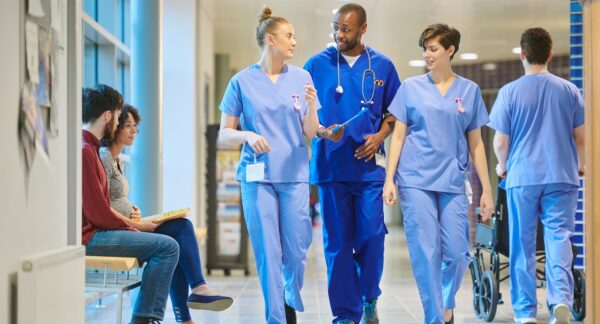Significant steps have been made towards developing pre-clinical muscle models to potentially speed up the availability of new treatments for muscular dystrophy. This is the result of hard work by researchers at University College London and the Francis Crick institute, including PhD student Moustafa Khedr and Dr Luca Pinton, led by Professor Francesco Saverio Tedesco.
Muscular Dystrophy UK-funded researchers identify an approach to making muscles in the laboratory

Skeletal muscles are the muscles we use to move our bodies. They are made up of long fibres, capable of producing the physical forces required for movement. These muscle fibres are supported by an intricate range of other cells, each with their own unique and essential function. Recreating this intricate system in the laboratory is invaluable to scientists researching skeletal muscles and their associated conditions, such as muscular dystrophies. Creating a biologically accurate imitation of skeletal muscles has the potential to speed up studies to develop new treatments for muscle-wasting conditions.
Producing mini muscles in laboratory
The researchers at University College London and The Francis Crick Institute set out to identify the necessary laboratory steps to convert stem cells into skeletal muscle.
Every person has stem cells in their tissue. They are generally taken from blood or bone marrow for research purposes. Stem cells are unique in that they can be converted into the cells of any organ or tissue, in this case, those that make up skeletal muscle. The key to achieving this is knowing the exact conditions that convert a stem cell into the different cell types required to make the relevant tissue.
Having converted the stem cells into muscle cells (for simplicity we will refer to them as mini muscles), the researchers placed them into three-dimensional water-based gels. This process generated the arrangement of cell types that make up skeletal muscle, including important blood vessels and nerve cells. Some mini muscles were created from cells donated from people with laminopathies, allowing the team to generate a model of the condition which could be studied and compared with healthy muscle. These mini muscles were then successfully used to investigate different types of therapies for treating muscular dystrophies, highlighting how this approach could be used to develop new treatments.
Benefits of generating mini muscles
One major successful outcome of this Muscular Dystrophy UK-funded study was that laboratory-generated muscle from muscular dystrophy patients could be used to better and more accurately capture the condition state than current models. This will assist further with therapy developments. Generating muscles in this way is also a great approach to replace and reduce animal use in pre-clinical research.
The procedures outlined in this study could easily be replicated by other scientists, allowing for widespread use to study muscle function and disease. Harnessing laboratory-engineered muscles could be hugely significant in understanding the driving conditions of skeletal muscles; increasing the number of therapies in clinical trials; and in aiding the development of more effective treatments for patients.
If you are interested in the step-by-step protocol, the full research article is available on this link.
This piece is written by Ben Futcher. Ben is studying for a doctorate (DPhil) in oncology at the University of Oxford, researching cell pathways involved in cancer. He got involved in writing for MDUK because he saw the effects of muscular dystrophy condition on classmates through primary school and wanted to use his understanding of science to help better communicate the exciting research being done to understand and treat these complex conditions.
‘What’s new in research’ is our monthly blog series that feature recent advancements in research into muscle-wasting conditions. Each month, a research article will be summarised for you by our research communications volunteers, all of whom have backgrounds in various fields of research.


